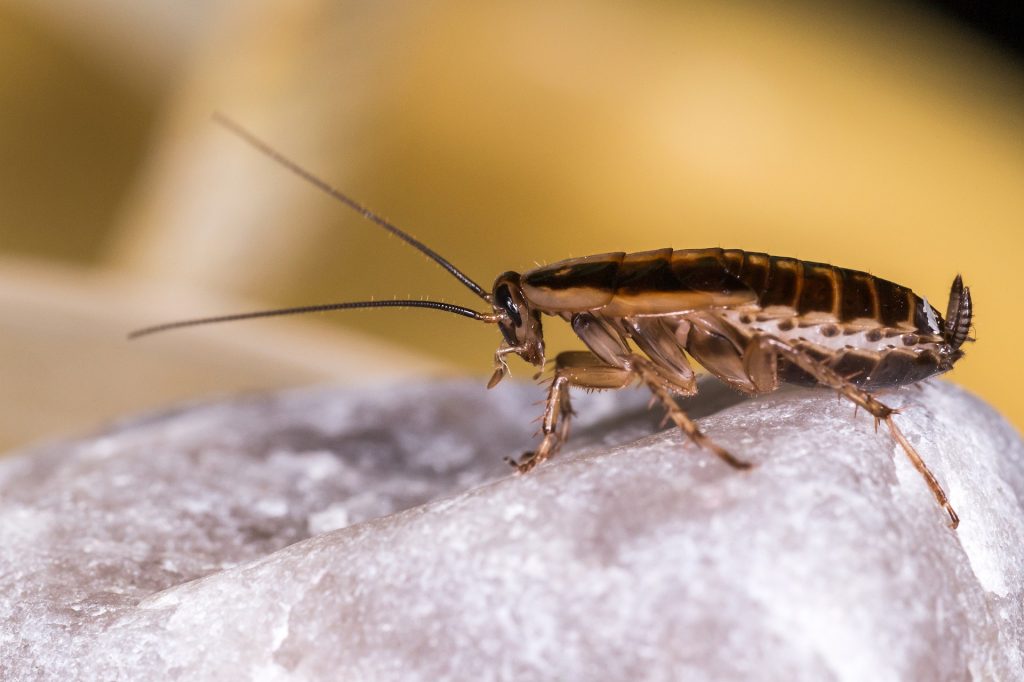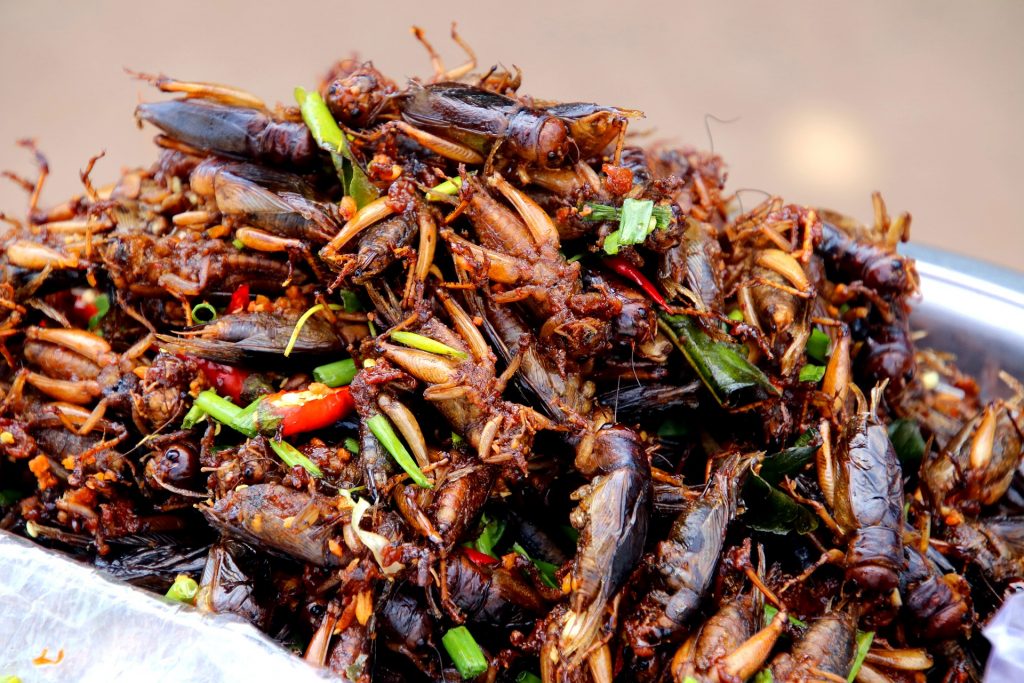
Blattella Germanica ©Pixabay/Erik_Karits
For some, the very thought on cockroaches is enough to make one’s skin crawl. These insects, which inhabit our planet for some hundreds of millions of years, are considered a plague that is difficult to treat and cure in many regions around the globe. In some cultures, however, they are also valued as a high-protein food and are even used in traditional Chinese medicine (TCM). We have taken a closer look at these crawling Blattodea, researched interesting facts and describe how to best prevent an infestation.
What are the benefits of cockroaches?
Cockroaches are a good source of food for birds and reptiles, but the insects’ excrement is also useful, as it is a valuable fertiliser.1
In China, insects are not necessarily considered a plague. The omnivorous cockroaches are used as waste recyclers and should help to solve the growing waste problem in the future. On many “farms” they eat several tons of kitchen waste every day. After death they serve as high-protein feed for chickens, pigs, etc. And as if that was not enough, medicine made from cockroaches can be bought in Chinese pharmacies.2 In China, these insects are believed to help against liver diseases, hepatitis and Cancer.3
If you like, you can also enjoy the insects as a small protein snack. They are said to be particularly tasty when deep-fried. 😉

Cockroach Salad ©Pixabay/Like_A_Hartman
The dangers of cockroaches
A cockroach infestation can quickly become a major plague if action is not taken fast enough, as they also reproduce rapidly. Wherever they appear, one automatically assumes poor hygienic conditions. Their presence is therefore unacceptable, especially in areas where food is stored, processed and/or sold.4
Cockroaches are known to transmit diseases and cause allergies.
For example, diseases are transmitted via the outside of the insect body, to which germs remain attached for up to 72 hours. Even when there has been no direct contact, the risk of infection is high because the insects contaminate their ‘habitat’ in search of food. The excrement of a cockroach can be pathogenic, too. The faeces can contain pathogens and allergens such as skin residues, which could trigger a house dust allergy.5
Cockroaches or the skin and fecal remains can also trigger asthma, from which children in particular suffer greatly. A study from the US has shown that children who are allergic to cockroach allergens and who have been exposed to them, have been in hospital or at the doctor’s more often and have more days absent from school or have even suffered from sleep disorders.6
The characteristics and properties of cockroaches
More than 4,500 different cockroach species exist world-wide and scientists are convinced that more than 5,000 species remain undiscovered or unnamed.7
Cockroaches are omnivorous, very adaptable and can adjust to a wide variety of living conditions. To survive and reproduce they need four important resources: food, water, warmth and hiding places.
In Europe, 3 species are the most widespread: Blattella germanica (German cockroach), Periplaneta americana (American cockroach) and Blatta orientalis (Oriental cockroach).4
Blattella germanica:
German cockroaches reach a size between 12 and 15 mm, are brown and have two dark stripes on the anterior segment of the thorax (prothorax). The wings are the same length as the body in males and females. This cockroach species runs very fast and can climb up (smooth) walls but cannot fly.
They mainly occur in heated buildings. Blattella germanica prefers high temperatures and humidity, for example in kitchens.
Periplaneta americana:
American cockroaches are reddish brown and grow to 28 to 44 mm in size. The wings of the males are longer than their bodies, whereas the wings of the females just cover the abdomen. These cockroaches can even fly at very high temperatures.
Periplaneta americana live mainly in buildings, sewers, cellars and pipe shafts.
Blatta orientalis:
Oriental cockroaches grow to 25 to 30 mm and are dark brown to black in colour. The wings of the female are only rudimentary, in males they cover most of the abdomen. Since Oriental cockroaches are large and also heavy, they do not climb like the other cockroach species, but stay on the ground.
They live in buildings, but unlike their relatives they also tolerate colder temperatures and can therefore be found outdoors.8
All cockroach females lay eggs in a so-called ootheca, which has two rows of eggs. Depending on the cockroach species, the purse-shaped egg capsule differs in size, colour and number of eggs growing inside. In the ootheca of the American and Oriental cockroach, there are typically 8 eggs per row, whereas the egg capsule of the German relatives of the cockroach species even has 15-20 eggs per capsule row.
The German cockroach carries the capsule in its abdomen until the nymphs are about to hatch. Other species do not carry the ootheca with them but attach them with a secretion in safe hiding places near food sources. To reach adulthood nymphs grow through a series of molts. Depending on the species this varies from 6 to 13 times.
The cockroach with the longest life expectancy is the adult female of the American cockroach, because it lives an average of 440 days, the males only 200. German cockroaches have a life expectancy of up to 200 days, the females of the Oriental cockroach live up to 181, their male companions only up to 160 days.9

Periplaneta Americana ©BioCycle (HK) Ltd
Signs of cockroaches and prevention with Bio/Clean Kill
With Bio/Clean Kill you can protect your home from cockroaches by treating all potential hiding places of these insects preventively. Spray all corners, cracks, crevices and tiny holes every few weeks with Bio/Clean Kill Classic or Bio/Clean Kill Micro-Fast to prevent cockroaches from settling in your home. Spray the treated areas extensively so that they are well moist, but not so much that it drips!
Especially relevant are warm and humid areas such as under sinks or behind refrigerators in kitchens.
However, if you find signs such as live/dead cockroaches, molting remains, traces of excrement and/or feeding damage, this could indicate an infestation.10
Cockroaches also spread an unpleasant odor, a mixture of their excrement, a liquid that they expel from their abdominal scent glands and a dark liquid that they regurgitate out of their mouth when eating.11
If you make these observations in your home, we recommend that you contact a professional pest management company immediately. Only a specialist can ensure that an infestation is brought 100% under control. In professional pest control, modern businesses also rely on Jesmond’s water-based and highly effective PCO products.
If you turn on the lights at night and see one cockroach, for sure there will be many more in hiding. If you see cockroaches during the daytime, this indicates that their hiding places are overrun and the population is huge and out of control.
Exciting facts about cockroaches
- Cockroaches are also kept as pets. Many large, slow-moving tropical species, such as the Madagascar hissing cockroach, have become popular pets.12
- Limbs grow back. Extracted limbs, such as the legs, grow back within 10 days.
- Cockroaches are highly sensitive. Their Antennae act as their ears and nose. Hairs on their legs are sensitive to vibrations. At the very end of the abdomen are a pair of cerci. These super sensitive organs are connected directly to the legs as a kind of second brain. The moment they sense vibrations the cockroach will start running.
- They can survive 9 days without a head. Cockroaches have a “decentralized physique”, which means that only part of the nervous system is located in the head. Other “mini-brains” are located in the cockroach’s body. For example, the cerci control the legs via abdominal nerve ganglia.3 Without water, however, the insects can only survive for a week, whether with or without a head.
- They are not immune to radiation. It is true that cockroaches survive much higher levels of radiation than we humans, but it is a myth that cockroaches can survive a nuclear explosion. However, cockroaches were actually found alive after the 1986 Chernobyl nuclear disaster. This resistance explains why it is probably one of the oldest surviving insects.
- 40 min without air, 30 min under water
Researchers have shown that cockroaches can hold their breath for up to 40 minutes and survive under water for up to 30 minutes. Cockroaches do not use their mouth to breathe, but small holes in their body called stigmas. These are also useful for saving water, because then the breathing holes are simply closed. - Cockroaches are cannibals
It is assumed that cockroaches follow a self-regulating order. If there is a very large population but only limited food supplies, the insects also eat their own to reduce the Population. - They can squeeze through tiny holes. The impressive exoskeleton gives the cockroaches special mobility. Thanks to the side-mounted legs, a cockroach can squeeze through an opening that is only a quarter of its body height.13
Risk of confusion with harmless wood cockroaches
In Europe – especially in regions surrounding the alps – certain insects cause concern because they look very similar to the German cockroaches. These are described as ‘Garden cockroaches’ (Ectobius vittiventris) from the wood cockroach family (Ectobiinae), which are completely harmless. In contrast to other household cockroach pests, Amber Wood Cockroaches are active during the daytime and feel most at home in forests and parks. They do not survive long in apartments. It is therefore worth looking twice and releasing these insects again.14
Due to the ability for cockroaches to rapidly reproduce, prevention is certainly advisable, easier, cheaper and more hygienic than fighting established colonies.
Click here to see: WORLD OF COCKROACHES – REFERENCES